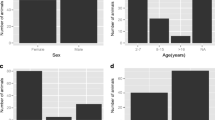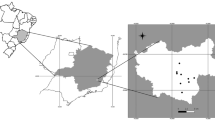Abstract
Gasterophilus larvae are common obligate parasites of the digestive tract of the equids. Horses become infected with this parasite by ingesting the larvae hatched from eggs laid by the female flies. In this study carried out monthly, we (i) counted the Gasterophilus eggs deposited by female flies on the coat of 30 grazing horses, (ii) counted and identified the Gasterophilus larvae retrieved from the digestive tract of 128 slaughtered horses, and (iii) compared these results to meteorological data. Eggs were deposited on all monitored horses, and were present from October to January and from May to September, whereas they were absent from February to April. The number of laid eggs was significantly different between the months, body regions, genders, and age classes (p < 0.05). Larvae were recovered in 112 (87.5 %) horses, and 6 species of Gasterophilus were identified. The prevailing species were Gasterophilus intestinalis (recovered in 110 horses; 85.9 %) and Gasterophilus nasalis (69 horses; 53.9 %), recovered in all months. Gasterophilus inermis (5 horses; 3.9 %), Gasterophilus pecorum (3 horses; 2.3 %), Gasterophilus haemorrhoidalis (3 horses; 2.3 %)¸ and Gasterophilus meridionalis (2 horses; 1.6 %) larvae were also found. Significant differences were found among monthly larval burdens for both Gasterophilus spp. and G. intestinalis (p < 0.05), but not for G. nasalis (p > 0.05). Larval burdens and prevalences did not differed significantly between both genders and age classes (p > 0.05). Monthly eggs and larvae trends were not significantly correlated (p > 0.05). With regard to the meteorological variables, minimum air temperature was significantly correlated with the eggs trend (rho = 1.000; p < 0.001) and maximum air temperature with the Gasterophilus spp. (rho = 0.972; p < 0.001) and G. intestinalis (rho = 0.972; p < 0.001) larvae trends. In addition, the number of hours with a temperature below +10 °C was significantly correlated with G. intestinalis larvae trend (rho = 0.602; p < 0.05). Our findings confirmed that in Sardinia, Gasterophilosis is an important parasitosis in the horses, and it needs more attention and extensive and/or correct treatment to reduce its prevalence.


Similar content being viewed by others
References
Agneessens J, Engelen S, Debever P, Vercruysse J (1998) Gasterophilus intestinalis infections in horses in Belgium. Vet Parasitol 77:199–204
Anazi ADAL, Alyousif MS (2011) Prevalence of non-strongyle gastrointestinal parasites of horses in Riyadh region of Saudi Arabia. Saudi J Biol Sci 18:299–303
Bernard N, Colobert C, Tariel G, Lamidey C (1994) Epidemiological survey of bot infection in horses at necroscopy in Normandy from April 1990 to March 1992. Rec Méd Vét 170:231–235
Brocard P, Pfister K (1991) Approche de l’épidémiologie de la gastérophilose du cheval en Suisse. Schweiz Arch Tierheilkd 133:409–416
Bucknell DG, Gasser RB, Beveridge I (1995) The prevalence and epidemiology of gastrointestinal parasites of horses in Victoria, Australia. Int J Parasitol 25:711–724
Bush AO, Lafferty KD, Lotz JM, Shostak AW (1997) Parasitology meets ecology on its own terms: Margolis et al. revisited. J Parasitol 83:575–583
Cogley TP, Cogley MC (2000) Field observations of the host-parasite relationship associated with the common horse bot fly, Gasterophilus intestinalis. Vet Parasitol 88:93–105
Coles GC, Pearson GR (2000) Gasterophilus nasalis infection: prevalence and pathological changes in equids in south-west England. Vet Rec 146:222–223
Cope SE, Catts EP (1991) Parahost behavior of adult Gasterophilus intestinalis (Diptera: Gasterophilidae) in Delaware. J Med Entomol 28:67–78
Felix SR, Silva CE, Schmidtt E, Quintana Nizoli L, Mendes Götze M, Silva da Silva S (2007) Presence of Gasterophilus (Leach, 1817) (Diptera: Oestridae) in horses in Rio Grande do Sul State, Brazil. Parasitol Latinoam 62:122–126
Garippa G, Polinas L, Merella P, Scala A, Nieddu AM, Murgia A (2004) Epidemiological findings on equid entoparasitoses in Sardinia. Parassitologia 46(suppl 1):45
Gawor JJ (1995) The prevalence and abundance of internal parasites in working horses autopsied in Poland. Vet Parasitol 58:99–108
Gökçen A, Sevgili M, Altaş MG, Çamkerten İ (2008) Presence of Gasterophilus species in Arabian Horses in Sanliurfa Region. Türkiye Parazitol Derg 32:337–339
Höglund J, Ljungström BL, Nilsson O, Lundquist H, Osterman E, Uggla A (1997) Occurrence of Gasterophilus intestinalis and some parasitic nematodes of Horses in Sweden. Acta Vet Scand 38:157–166
Lyons ET, Swerczek TW, Tolliver SC, Bair HD, Drudge JH, Ennins LE (2000) Prevalence of selected species of internal parasites in equids at necroscopy in central Kentucky (1995-1999). Vet Parasitol 92:51–62
Niedźwiedź A, Borowicz H, Nicpoń JM (2013) Prevalence study in horses infected by Gasterophilus sp. in an eastern region of Poland. Vet Parasitol 191:94–96
Otranto D, Milillo P, Capelli G, Cowell DD (2005) Species composition of Gasterophilus spp. (Diptera, Oestridae) causing equine gastric myiasis in southern Italy: Parasite biodiverity and risks for extinction. Vet Parasitol 133:111–118
Rehbein S, Visser M, Winter R (2013) Prevalence, intensity and seasonality of gastrointestinal parasites in abattoir horses in Germany. Parasitol Res 112:407–413
Sequeira JL, Tostes RA, Oliveira-Sequeira TC (2001) Prevalence an macro- and microscopic lesions produced by Gasterophilus nasalis (Diptera: Oestridae) in the Botucatu Region, SP, Brazil. Vet Parasitol 102:261–266
Sievers G, Weber B (2005) Período de oviposición de Gasterophilus nasalis y G. intestinalis en equinos. VIII Región, Chile. Arch Med Vet 37:169–172
Sweeney HJ (1990) The prevalence and pathogenicity of Gasterophilus intestinalis larvae in horses in Ireland. Irish Vet J 43:67–73
Urquhart GM, Armour J, Duncan JL, Dunn AM, Jennings FW (1998) Parassitologia veterinaria. UTET, Torino
Zumpt F (1965) Myasis in Man and Animal in the Old World. Butterworts, London
Acknowledgments
Part of this study has been presented as an abstract at the LXII Annual Meeting of the Italian Society for Veterinary Sciences (S.I.S.Vet.; San Benedetto del Tronto, Ascoli Piceno, 24th–26th September 2008), and, among selected abstracts, translated and published in Veterinary Research Communications (2009, vol. 33 (Issue 1 Supplement), pp. S149–S151).
Ethical statement
This study complies with the current laws of both the Italian Republic and the European Union, and it was performed in accordance with the national guidelines for animal welfare.
Conflict of interest
The authors declare that they have no conflict of interest.
Author information
Authors and Affiliations
Corresponding author
Rights and permissions
About this article
Cite this article
Pilo, C., Altea, A. & Scala, A. Gasterophilosis in horses in Sardinia (Italy): effect of meteorological variables on adult egg-laying activity and presence of larvae in the digestive tract, and update of species. Parasitol Res 114, 1693–1702 (2015). https://doi.org/10.1007/s00436-015-4352-z
Received:
Accepted:
Published:
Issue Date:
DOI: https://doi.org/10.1007/s00436-015-4352-z




